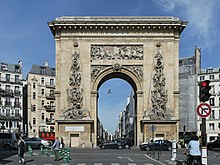François Blondel (architect)
Nicolas-François Blondel (* around 1618 in Ribemont ; † January 21, 1686 in Paris ) was a French builder and engineer who achieved the highest honors as a marshal and diplomat . He is considered to be one of the most important theorists of rationalist architecture of Colbert's time. Since 1669 he was a member of the Académie des sciences .
Life
Coming from a family of court officials and as a fortress builder "during an eventful life in the military", he studied engineering and mathematics , but soon turned to the fine arts. He became a diplomat in missions in Italy, Greece, Turkey and Egypt, but also an educator and travel companion for several noble sons, including those of Colbert.
Académie Royale
He was appointed by him in 1672 as the first director of the Académie royale d'architecture in Paris. Founded by state regulation, the Académie, which was founded by Colbert along with others on the model of the Académie Française , had the task of developing, enforcing and promoting binding rules and standards of architectural theory abroad. The Académie initially consisted of a total of eight members who first read and sift through the available literature and then form a canon of literature and topics. While medieval architecture was quickly rejected as unbearable , the assessment of ancient evidence and sources of the (Italian) Renaissance was much more controversial, also because of the lack of usable building recordings. This resulted in the Querelle des anciens et des modern , a dispute over the direction of which Blondel can be regarded as the conservative protagonist.
Architectural theory
The main work of his theoretical writings, Cours d'Architecture (1675–1683), is the result of Blondel's lectures given twice a week to the Académie and a clear expression of the rationally built French architectural theory. Here he consistently represents a concept of development from the simple to the refined, a consistency of the architecture from the original hut to the differentiated column arrangements, which form a closed system that is deaf to objections and contradicting developments.
Blondel created the Triumphal Arch Porte Saint-Denis in place of the city wall that was just demolished there under Louis XIV .
Works
Buildings
- Porte St.-Denis , Paris, 1672
- First draft for the Berlin Zeughaus , 1685
Fonts
- Cours d'Architecture , volumes 1–5, Paris 1675–1683 Online: Volume 1 , Volume 2/3 Volume 4/5 (University of Heidelberg)
- The art of throwing bombs, that is: A new-found way of finding the widths and heights of the throws and bow-shots, according to all kinds of elevations of the pieces or firecrackers. Nuremberg 1686, digitized version of the Saxon State Library - Dresden State and University Library
- New way of building vestibules. Nuremberg 1686, digitized version of the Saxon State Library
Reprints
- Résolutions des quatre principaux problemèmes d'architecture par M. Blondel et Ouvrages de Mathématique de M. Frénicle . Mortier, Amsterdam 1736, urn : nbn: de: kobv: 83-goobi-950526
literature
- Antoine Picon: Architectes et ingénieurs au siècle des lumières. Parenthèses, Marseilles 1988, ISBN 2-86364-049-6
- Hanno-Walter Kruft: History of Architectural Theory: From Antiquity to the Present. Verlag CH Beck, Munich 2004, ISBN 3-406-34903-X
- Christian Freilang: François Blondel. In: Bernd Evers (ed.): Architectural theory: From the Renaissance to the present . Taschen Verlag, Cologne 2006, ISBN 3-8228-5082-9
- Alfred Werner Maurer , Vanessa Alexia Maurer-Schwindt (eds.): Disput François Blondel and Claude Perrault : The dispute between Francois Blondel and Claude Perrault about the natural origin of architectural proportions and the crisis of architectural theory, urn : nbn: de: 0277- 17 , DNB 1005758018/34
Web links
- Literature by and about François Blondel in the catalog of the German National Library
- Publications by and about François Blondel in VD 17 .
- Digitized writings by Blondel from Heidelberg University Library
Individual evidence
- ↑ The date of birth is still unknown today. Kruft mentions 1617 and refers to Henry Lemonnier (ed.): Procès-Verbaux de l'Academie Royale d'Architecture 1671–1793 . Paris 1911.
- ↑ The Little Encyclopedia . Encyclios-Verlag, Zurich 1950, Volume 1, p. 195
- ^ List of members since 1666: Letter B. Académie des sciences, accessed on September 21, 2019 (French).
- ↑ Kruft 2004, p. 146
- ↑ a b Evers et al. 2006, p. 156
- ↑ Kruft 2004, p. 147
| personal data | |
|---|---|
| SURNAME | Blondel, François |
| ALTERNATIVE NAMES | Blondel, Nicolas-François |
| BRIEF DESCRIPTION | French builder and architectural theorist |
| DATE OF BIRTH | around 1618 |
| PLACE OF BIRTH | Ribemont |
| DATE OF DEATH | January 21, 1686 |
| Place of death | Paris |


